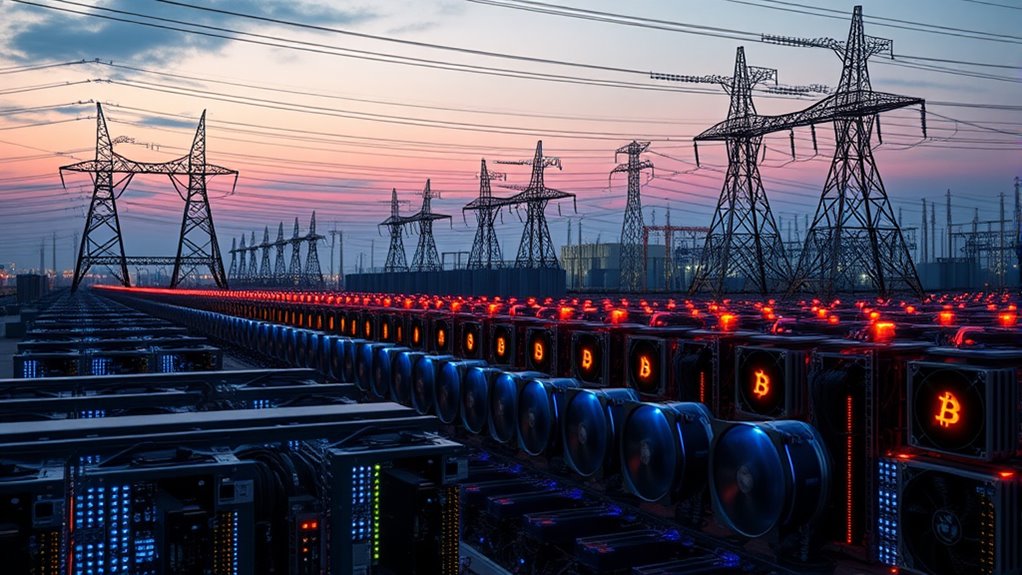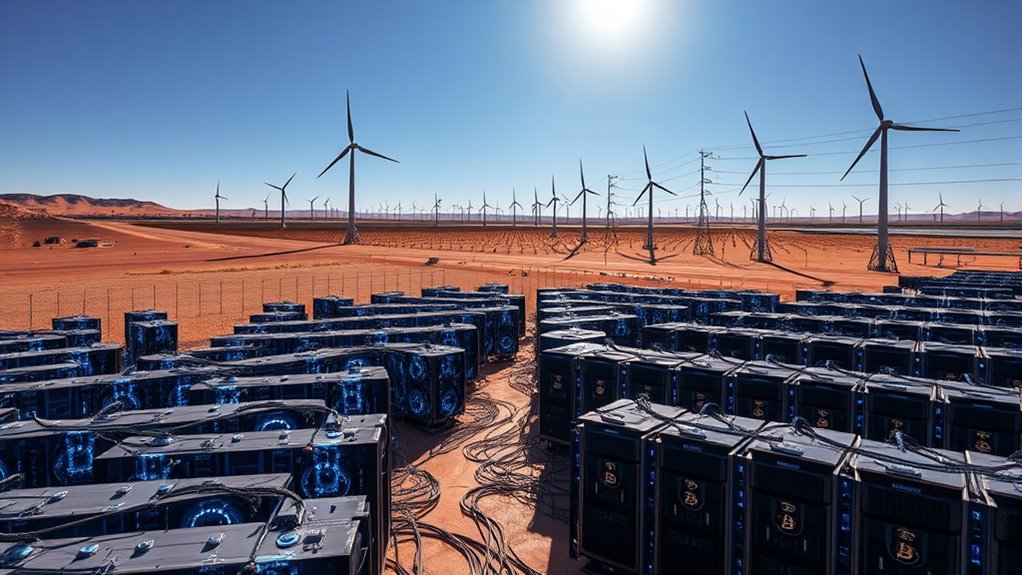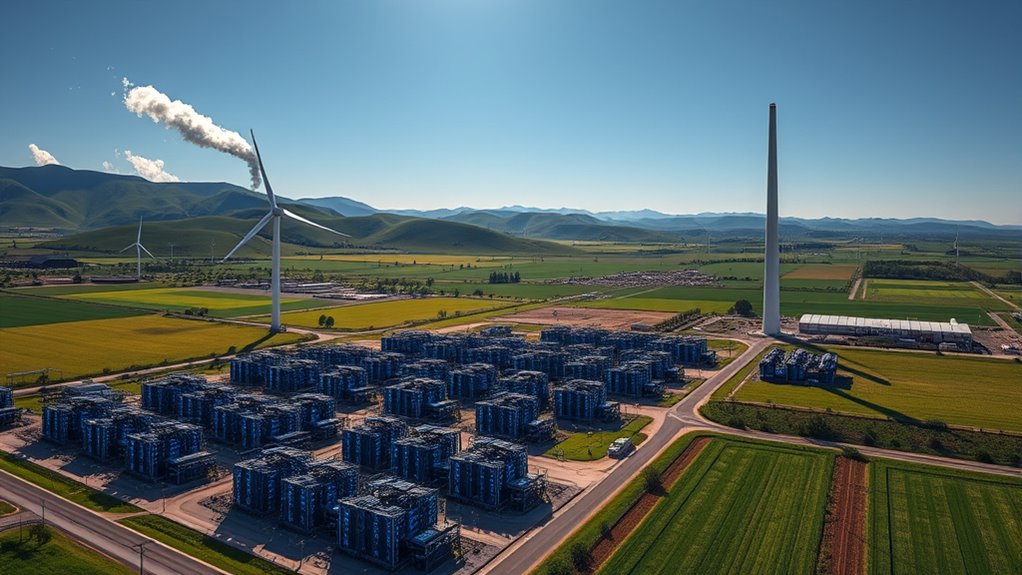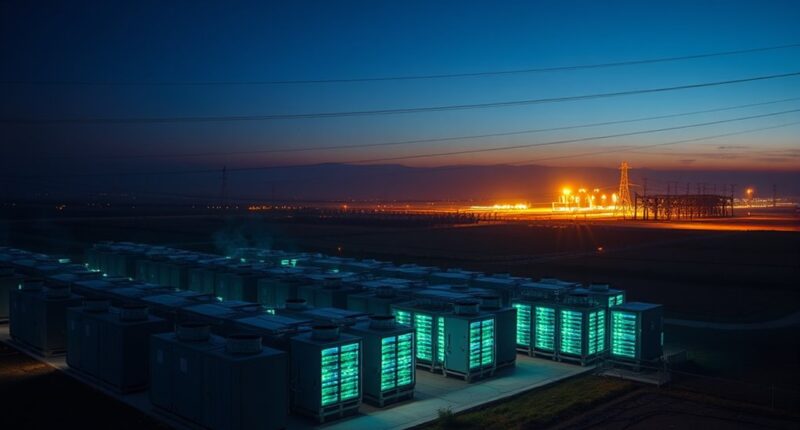Bitcoin mining is boosting U.S. energy grids by using flexible, demand-responsive loads that help balance power supplies. Miners can ramp up or reduce energy use quickly, supporting renewable sources like wind and solar, which are intermittent. This flexibility aids grid stability and reduces reliance on fossil fuels in some regions. If you want to understand how this synergy is shaping the future of energy and blockchain, keep exploring further.
Key Takeaways
- Bitcoin mining provides flexible, rapid load adjustments that help stabilize U.S. energy grids and prevent outages.
- Mines absorb excess renewable energy during high generation periods, reducing curtailment and enhancing renewable integration.
- Mining operations’ ability to ramp up or down supports grid balancing, particularly with intermittent wind and solar sources.
- Mining can incentivize investment in renewable infrastructure by increasing demand for clean energy sources.
- Regional mining flexibility and renewable commitments contribute to more resilient, sustainable U.S. energy networks.

Over the past few years, U.S. Bitcoin mining has markedly increased its share of national energy consumption. In 2023, estimates show it uses between 25 and 91 terawatt-hours annually, accounting for roughly 0.6% to 2.3% of U.S. electricity demand. This range is comparable to the annual power use of 3 to 6 million average homes. The country’s share of global Bitcoin mining surged from 3.4% in January 2020 to nearly 38% in early 2022, maintaining that level today. With 137 identified mining facilities, most are concentrated in Texas, Georgia, and New York. The growth reflects the migration of mining capacity to the U.S., drawn by affordable power, favorable regulations, and grid flexibility programs, making it a major player in the global mining landscape. Additionally, the increasing use of renewable energy sources by some mining operations helps mitigate environmental concerns associated with high energy consumption.
Geographic Hotspots: Texas, Georgia, and New York Leading the Charge

Texas, Georgia, and New York have emerged as the primary hubs for Bitcoin mining in the United States, driven by their abundant and affordable energy resources. Texas leads the way with its vast, inexpensive, and deregulated power grid, making it attractive for miners who participate in demand response programs that help stabilize the grid. Georgia benefits from its reliable and low-cost energy, especially from nuclear and natural gas plants, attracting large-scale operations. New York offers a mix of renewable energy sources and competitive electricity prices, encouraging miners to set up shop. These states’ favorable policies, access to diverse energy sources, and grid flexibility make them ideal locations for mining operations. As a result, they dominate U.S. Bitcoin mining capacity, shaping regional energy markets and grid dynamics. Grid flexibility is a crucial factor that allows these regions to accommodate the fluctuating energy demands of mining operations while maintaining overall grid stability.
Mining as a Flexible Energy Resource: Supporting Grid Stability and Demand Response

You can leverage Bitcoin mining’s ability to rapidly reduce power consumption when grid demand peaks. By offering incentives for load curtailment, miners help maintain grid stability and prevent outages. This flexible energy use makes mining a valuable tool for supporting a balanced and resilient energy system.
Rapid Load Curtailment
Bitcoin mining operations are uniquely suited as flexible energy loads because they can rapidly adjust their power consumption in response to grid conditions. This ability enables miners to provide fast demand response, helping stabilize the grid during peak times or shortages. When demand spikes, miners can quickly reduce their electricity use, easing pressure on the grid. Conversely, they can ramp up operations when supply is abundant. This rapid load curtailment supports grid reliability and integrates renewable energy sources efficiently. Additionally, their capacity to modulate energy use supports grid stability during variable renewable generation.
Incentivizing Grid Balance
Harnessing the flexibility of Bitcoin mining operations offers a powerful way to enhance grid stability and balance supply and demand. By adjusting power consumption in real-time, miners can respond quickly to grid signals, providing valuable demand response services. This flexibility allows miners to turn off or scale down operations during peak demand periods, helping utilities avoid outages and reduce reliance on fossil fuel peaker plants. In return, miners receive financial incentives, such as payments or lower energy costs, for their participation. This dynamic creates a mutually beneficial relationship: miners support grid stability while optimizing their operations. As more states recognize mining’s potential as a flexible resource, policies increasingly encourage its integration into grid management strategies, making Bitcoin mining a key player in balancing U.S. energy systems. AI security solutions can also assist in managing the digital infrastructure supporting these energy systems, ensuring their resilience against cyber threats.
The Role of Renewables in Powering U.S. Bitcoin Mining Operations

Renewables play a growing role in powering U.S. Bitcoin mining, with over half of the energy reportedly coming from renewable sources by 2025. However, regional differences mean some states rely heavily on fossil fuels despite abundant renewable potential elsewhere. Understanding these variations helps assess how mining can support a more sustainable energy future. Incorporating sound design techniques into the development of mining infrastructure can further enhance efficiency and environmental benefits.
Renewable Energy Share
The renewable energy share powering U.S. Bitcoin mining is growing steadily. Currently, over 50% of the energy used for mining is reportedly from renewable sources, reflecting increased investments in solar, wind, and hydro power. Miners are increasingly drawn to regions with abundant renewable resources, helping reduce their carbon footprint and lower energy costs. However, regional differences exist—some states like Texas and Kentucky still generate a significant portion of mining electricity from fossil fuels, with renewable shares as high as 85%. The sector’s self-reported data can vary, making exact figures difficult to verify. Despite these challenges, the trend toward renewables is clear, driven by policy incentives, falling costs, and miners’ desire to align with environmental goals. Additionally, advances in energy efficiency technologies are enabling miners to maximize output while minimizing their environmental impact. This shift supports a cleaner, more sustainable future for Bitcoin mining.
Regional Variations in Renewables
Regional differences markedly influence how much renewable energy powers U.S. Bitcoin mining. In states like Texas and California, abundant wind and solar resources mean miners often access cleaner energy sources, boosting renewable shares. Conversely, states like Kentucky and parts of the Midwest rely heavily on coal and natural gas, limiting renewables’ role in mining operations. Local policies and energy prices also shape these regional variations, encouraging miners to locate where renewables are plentiful and affordable. Texas, in particular, benefits from a flexible grid and demand response programs, making renewable-powered mining more feasible. Meanwhile, states with less renewable infrastructure see higher fossil fuel dependence. These regional differences directly impact the environmental footprint of mining, highlighting the importance of local energy mixes and policies in shaping sustainable growth. Additionally, the integration of energy storage technologies can enhance the use of renewables in regions with variable generation, further promoting sustainable mining practices.
Impact on Grid Sustainability
As U.S. Bitcoin mining expands, its impact on grid sustainability becomes clearer. Miners often choose locations with abundant renewable resources, helping reduce reliance on fossil fuels. Their flexible loads can quickly ramp up or down, supporting the integration of intermittent renewables like wind and solar. Texas miners, for example, participate in demand response programs, providing grid stability and reducing carbon emissions. However, in some states like Texas and Kentucky, a significant share of mining energy still comes from fossil fuels, challenging sustainability goals. Overall, mining can promote grid resilience by acting as a flexible demand that supports renewable energy growth. Yet, the environmental benefits depend heavily on regional energy mixes and miners’ commitment to renewable sources. Proper regulation and transparency are vital for maximizing sustainability. Additionally, understanding the health implications of energy consumption patterns can help ensure that increased mining activity aligns with broader environmental and public health goals.
How Mining Flexibility Enhances Renewable Integration and Grid Resilience

Mining operations are uniquely positioned to boost renewable energy integration and strengthen grid resilience because of their inherent flexibility. You can rapidly adjust mining loads, curtailing or ramping up power consumption as grid conditions change. This capability helps balance intermittent renewable sources like wind and solar, which can fluctuate throughout the day. When renewable generation is high, mines can increase activity, absorbing excess power and preventing curtailment. During peak demand or low renewable output, they can reduce consumption, easing pressure on the grid. This dynamic response supports grid stability and improves renewable energy utilization. Additionally, mining flexibility can help mitigate spikes in energy demand, making renewable integration more practical and reliable for the overall energy system.
Regional Variations: Fossil Fuel Dependence Versus Renewable Adoption in Major Mining States

While U.S. states like Texas, Kentucky, and Georgia have become hotspots for Bitcoin mining, their energy sources vary markedly. In Texas, abundant natural gas and wind power dominate, with up to 85% of mining energy from fossil fuels in some areas. Kentucky relies heavily on coal, making fossil dependence high, while Georgia benefits from a mix of natural gas and increasing renewable investments. Your focus should be on these key differences:
- Texas’s flexible grid and cheap, diverse energy attract miners, but fossil fuels still play a large role.
- Kentucky’s reliance on coal results in higher carbon footprints, despite some renewable growth.
- Georgia is shifting toward renewables, yet fossil fuel use remains significant.
- Local policies and energy costs drive where miners choose to operate, shaping regional energy profiles.
- Understanding the energy mixture in each state helps clarify how regional policies and resource availability influence the environmental impact of Bitcoin mining.
The Broader Impact: U.S. Mining’s Contribution to Global Electricity Consumption

U.S. Bitcoin mining accounts for roughly 38% of global mining activity, consuming between 25 and 91 TWh annually. This is comparable to the electricity used by small nations like Thailand or the Netherlands. Your country’s mining efforts profoundly contribute to worldwide energy demand, which totals around 173 to 212 TWh each year. While U.S. mining’s share of global consumption remains substantial, it represents just a tiny fraction—about 0.8%—of global electricity use. This large-scale energy demand impacts global efforts to reduce carbon emissions, especially since some mining operations still rely heavily on fossil fuels. However, the U.S. is increasingly integrating renewables into mining, shaping its role as both a major energy consumer and a potential leader in sustainable practices.
Policy and Market Dynamics Shaping the Future of Bitcoin Mining and Energy Grids

Policy and market dynamics are rapidly transforming the landscape of Bitcoin mining and its integration with energy grids. You need to stay aware of how regulations, incentives, and market forces influence where and how mining operates. These factors determine whether miners can access cheap, renewable energy or face restrictions due to environmental concerns. As policies evolve, some states incentivize mining as a flexible grid resource, while others impose restrictions. Market conditions, like electricity prices and Bitcoin’s market value, also steer miners’ decisions.
- Regulations and incentives shape mining location and operations
- Demand response programs enhance grid stability and offer payments
- Renewable energy claims vary regionally and are often self-reported
- Market volatility influences profitability and hardware investments
Frequently Asked Questions
How Accurately Can Mining Companies Report Their Renewable Energy Usage?
Mining companies often overstate their renewable energy use because they rely on self-reported data without standardized verification. You can’t always trust their claims since there’s no centralized reporting or strict oversight. They may highlight renewable sources to improve their image or attract investment, but actual figures can vary widely by region and reporting practices. As a result, evaluating their true renewable energy consumption remains challenging and somewhat uncertain.
What Are the Environmental Impacts of Fossil-Fuel-Powered Bitcoin Mining?
Fossil-fuel-powered Bitcoin mining considerably impacts the environment by generating substantial CO₂ emissions, contributing to climate change. Many mining operations, especially in states like Texas and Kentucky, still rely heavily on coal and natural gas, which release pollutants and harm air quality. This reliance increases the carbon footprint, stressing the need for greater renewable energy use and stricter regulations to reduce environmental damage caused by these energy-intensive activities.
How Does Bitcoin Mining Influence Regional Electricity Prices?
Bitcoin mining influences regional electricity prices by increasing demand, especially in areas with cheap, renewable, or fossil fuel-based power. When miners set up operations, they often consume significant energy, which can drive up prices during peak periods. However, in regions like Texas that participate in demand response, miners help stabilize prices by reducing consumption when the grid is stressed, balancing supply and demand effectively.
Are There Specific Policies Encouraging or Restricting Mining in Key States?
Policies are like traffic signals for miners. In key states, Texas offers green lights with incentives for flexible, renewable-backed operations, encouraging growth. Conversely, some states impose restrictions due to environmental concerns, acting as red lights. These policies shape where miners set up shop, balancing economic opportunity with ecological responsibility. Your awareness of these regulations helps you understand how government decisions steer the future of Bitcoin mining across the U.S.
How Might Cryptocurrency Market Fluctuations Affect Energy Grid Support?
Market fluctuations can considerably impact your energy grid support from cryptocurrency mining. When Bitcoin prices drop, miners may reduce operations or shut down, easing demand and helping stabilize the grid. Conversely, rising prices encourage more mining activity, increasing energy consumption and potential strain. Your grid’s flexibility benefits from this dynamic, as miners can quickly ramp up or down, acting as a buffer during supply and demand shifts.
Conclusion
As you see, Bitcoin mining is becoming a powerful force shaping U.S. energy grids. It offers opportunities to support renewable integration and enhance grid stability, but also comes with challenges. Remember, every cloud has a silver lining—your understanding of mining’s role can help shape smarter, greener energy policies. Stay informed and engaged, because in the end, energy shifts depend on those who know how to turn challenge into opportunity.









